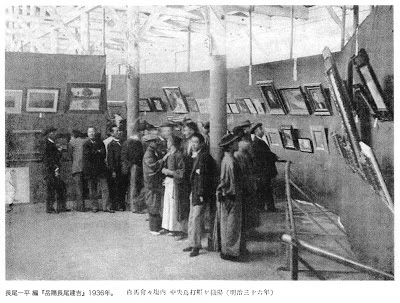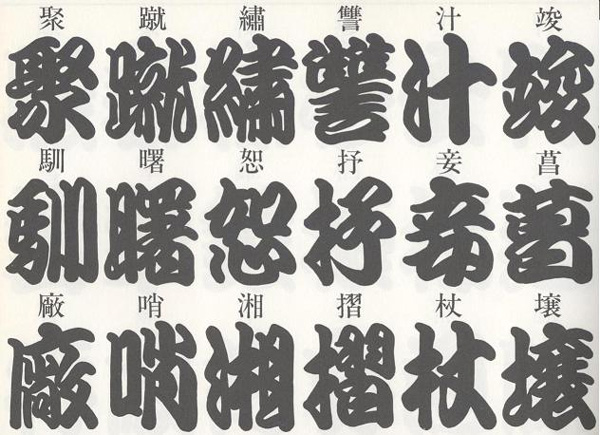A-M aragoto - a kabuki bombastic style exaggerating all the aspects of the role (acting, wig, make-up, costumes, dialogues, oversized swords) to portray valiant warriors, fierce gods or demons. It is the opposite style of the soft wagoto. It is sometimes referred to in English as the "rough-stuff" style. aratame - single seal on a print containing the  bakufu - military government of the shogun. baren - flat circular convex printing tool believed to have been originally introduced from China. The baren is used on the back of the paper to transfer the image from the inked block onto the paper. The technique whereby the baren marks are emphasized intentionally is known as baren-sujizuri. While modern barens are made of various materials, the traditional baren consists of an inner core of tightly twisted and coiled strips of bamboo sheath sandwiched between a back plate consisting of a laminate of thin kozo paper and cover of bamboo sheath. bijin-ga - pictures of beautiful women. This term was originally gender neutral but by the second half of the 18th century it was mainly used for women. bokashi - a gradual gradation of colored ink achieved during the printing of woodblock prints by varying the application of ink to the block from light to dark. budōgoto - roles or things related to the warrior class. bunmei kaika-e (civilization and modernization pictures) - bunmei kaika was the Meiji government's slogan for the introduction of Western science, culture and ideology after the Meiji-Restoration of 1868. The incorporation of many of these Western ideas and things into the Japanese lifestyle often made for amusing results and bunmei kaika-e often made fun of the results. One typical example is the combination of Western and Japanese fashion elements as Western skirts worn with Japanese shoes or Japanese kimonos worn with Western hats and accessories etc. (also see kaika-e and Yohohama-e.) bunjinga - Chinese literati painting bunraku - a traditional Japanese puppet theater, combining jōruri chanting and puppetry. Bunten - an abbreviation for Monbusho Bijutsu Tenrankai (Exhibition of Fine Arts by the Ministry of Education), the Ministry's annual art exhibition, whichstarted in 1907 and ran until 1918. It was the equivalent of the officialexhibitions of nineteenth century Europe and the route to recognitionand financial success. It showcased Japanese-style painting, western-style painting, and sculpture. (see also Teiten its 1919 successor.) chirimen-e ("crêped" print) - introduced around 1860, finished prints (created by the usual woodblock print process) are rolled around a bar and then rubbed to give it crinkles and creases as if it had been printed on crepe silk (chirimen 縮緬). This treatment causes the print to shrink to about two thirds of its original size, as a result of which lines take on special characteristics and the colors darken. daimyo - feudal regional lord. dōjin - The Japanese word dōjin (also dōnin) has two meanings: 'the same person' and 'a group of people who share the same objective or aspiration'. The term dojin zasshi (magazine) was derived from the second meaning, referring to magazines published by such groups. Edokko ("child of Edo") - someone whose family has lived in Edo for three generations. Characterized by a boisterous, quick-tempered nature; proud, daring and loose with his money so that he "never let the sun rise on his earnings." e-goyomi 絵暦 - pictorial calendar; illustration containing clues to the long and short months of the year ehon - woodblock-printed picture books. fūkei-ga - landscape or cityscape pictures. Landscape was not considered a typical subject for early ukiyo-e until the early 1720s. Landscape often served as a backdrop and emerged as a separate genre in the later 18th century. fukeoyama - actor specialized in old women roles. fukeyaku - old people roles. The actors playing female fukeyaku roles are called fukeoyama. The actors playing male fukeyaku roles are called oyajigata. fukurotoji ("pouch-binding") - The most common type of book-binding in Japan, made of thin sheets of paper which are inscribed or printed on only one side, folded in half, text/image side out, and stacked together. Covers are added to the front and back, and the book is stitched along the spine (the edges opposite the folds) so that each double-leaved page forms a pouch, fukuro 袋, which is open at the top and bottom. Although variations exist, typically four tiny holes are made at equidistant lengths along the spine edge and the sheets and covers are then bound together tightly with thread. fukuseiga (fukusei hanga)- reproduction print. A somewhat confusing term in that it is used both for woodblock print copies after original ukiyo-e and woodblock prints modeled after paintings, watercolors or drawings not otherwise intended for the print medium. fūzokuga – pictures of manners and customs. ga - when signing their works, artists frequently attached the suffix ga 画 (drawn by) or gakō (designed by) to their signatures.
gafu - picture book or album. gagō - art or studio name. Also seen as gō. geimei 芸名 - Usually used when referring to an actor's or entertainer's stage name. geisha - literally, "art person". A female performer specializing in entertaining and providing companionship to men at dinner parties. They are skilled in classic Japanese arts, such as music (esp. samisen), poetry and calligraphy. gō - artist name. An individual's name other than real name (honmei) or nickname (azana). In the case of artists one character of the teacher's name was passed on to the student to create a gagō or art name. Print designers could and did periodically change gagō. gofun - "shell white" made of calcium carbonate powder obtained by heating and pulverizing the shells of oysters and clams. In woodblock prints, gofun was sometimes rubbed directly on the picture surface, or sprinkled to give the effect of falling snow. This technique is called gofun-chirashi (shell white spattering). gōkan - books in which the story was written as a series of pamphlets liberally illustrated with woodblock prints and then bound as a single volume. haiku - a short poem in seventeen syllables, usually arranged in three 5-7-5 syllable phrases, often capturing a mood or feeling. haimyō - literary name of a kabuki actor. Hakubakai (White Horse Society, 1896-1915) - founded in 1896 by the painter Kuroda Seiki for the promotionand exhibition of works influenced by the French academic andImpressionist plein-air painting styles he had encountered while abroad. It was a rival to the conservative Meiji Art Society which also promoted Western style painting. Kuroda's White Horse Society is credited with changing the whole Japanese approach to Western art. Exhibition Hall of the Hakubakai, 1903 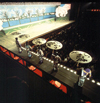 hanga - the general term for a print, first used in 1905 in the magazine Heitan which was founded by Yamamoto Kanae, Ishii Hakutei and a few others. hanshita-e - a preparatory drawing executed in black ink on thin paper pasted to a woodblock and used to carve the outlines of the design. harimaze-e- a print containing two or more subjects on a single page, designed to be cut apart and used for ornamenting small screens, etc. 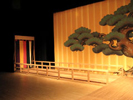 hikifuda 引札 - advertising prints, often given to customers as New Year gifts, carrying images associated with good luck, fortune and wealth.  hitsu 筆 - "brush" or "by the brush of", often used as a suffix in artists' signatures. hō - a shortened form of the word hōnoki (a species of Magnolia). Hō is a lightweight wood used as a woodblock in the mokuhan process. It is good for small prints, having an easily carved, soft and uniform texture. hōsho - a paper made with mulberry (kōzo) fibers, which are long, pliant, absorbent, and strong. Kizuki hōsho were traditionally used for ukiyo-e. It was the preferred paper for many sosaku hanga artists. Ichimoku-kai (The First Thursday Society) - crucialto the postwar revival of Japanese prints, was formed in 1939 by thegroup of people who gathered in the house of Onchi Kōshirō (1891-1955) in Tokyo.The group met once a month to discuss print related issues. It was considered the core of the sosaku hanga movement up until its demise in 1950. ichiranzu - panoramic view prints. Inten - an annual painting exhibition organized by the Saiko Nihon Bijutsu-in (Reorganized Japan Art Institute.) In 1914, a group of artists led by Yokoyama Taikan revived the Japan Art Institute, originally founded in 1898 by Okakura Tenshin, into the Saiko Nihon Bijutsu-in. itame mokuhan 板目木版 (literally "imitation woodgrain") - a tightly grained piece of wood is allowed to soak in water and then used like any other printing block. jidaimono - historical drama.jitsuaki - subdivision of katakiyaku: a jitsuaku is an evil conspirator or cruel villain. jitsugotoshi - subdivision of tachiyaku: a jitsugotoshi is a wise, righteous and clever man, who appears on stage at the right time to set the record straight, to solve an enigma or foil an evil plot. jo-no-mai - a dance performed in the introduction to a Noh play. jōruri - a type of sung narrative with shamisen accompaniment, typically found in bunraku, a traditional Japanese puppet theater. kabuki - a traditional Japanese form of theater with its origins in the Edo period. In contrast to the older Japanese art forms such as Noh, kabuki was the popular culture of the common townspeople and not of the higher social classes. kacho-e (or kacho-ga) - prints of birds and flowers. kagami no ma (mirror room) - the area just beyond the curtain where the performers gather and prepare themselves before a noh play. The main actor (shite) puts on his mask in front of the large mirror in this room. While the kagami no ma is located on the far side of the curtain, the stage continues into the room, and the performers consider it part of the stage. kaika-e - pictures of modernization that focused on advances (i.e. Westernization) in government, industry, architecture and science. Kamigata - The kabuki of Kamigata (old expression used for the Ôsaka-Kyôto-Kôbe-Nara region) The Kamigata kabuki main feature is the wagoto style. Nowadays, there are only a few Kamigata actors, led by the star Nakamura Ganjirô and his two sons Senjaku and Kanjaku. The others famous Kamigata actors are Kataoka Hidetarô, Bandô Takesaburô and Kamimura Kichiya, who are still living in the city of Ôsaka. Some actors like Kataoka Nizaemon, Kataoka Gatô or Nakamura Tomijûrô, born and educated in Tôkyô, living in Tôkyô, are also related to Kamigata kabuki because of their lineage. kamuro - courtesan's maid; female child attendant/apprentice to courtesan kamusō - mendicant Zen monk, or a person so dressed as a disguise kano - academic painting tradition originating in Chinese ink painting and flourishing in Japan from the late fifteenth century onward. The Kano school became the official painting school of the Tokugawa shogunate during the Edo period (1603-1868). Kanga-kai - an association of artists, founded in 1881 by Ernest Fenollosa, Okakura Kakuzo and several others, dedicated to saving traditional Japanese painting.
woodblock prints. It uses thick, rounded brushstrokes, with so few spaces it is sometimes nearly unreadable. kaō 花押 - a stylized signature or mark kata - In kabuki a set of stylized forms designed for one specific role and transmitted from generation to generation. katakiyaku - actor specialized in villain roles. katsureki (Plays of Living History) - new genre of jidaimono dramas, created by the star Ichikawa Danjûrô IX during the Meiji era. Theseplays were enactments of historical incidents performed in every detailwith all the accuracy that extensive research could reveal. kentō - theregistrationmarks (one right angle, into which the corner of the paper fits, and onestraight one, along one of the adjoining edges) used to ensure registrationof the different colors in multi-color woodblockprints. 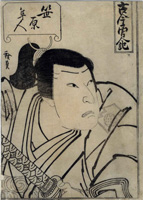 kibyōshi 黄表紙 - literally "yellow cover". Popular Edo literature of late 18th century. Illustrated books with humorous, irreverent stories. kirazuri - printing with mica dust. Kisokaidō - The inland route, also called the Nakasendō, stretching from Nihonbashi to Edo to Kyoto with 69 post-town, or stations, in between. (also see Tōkaidō.) kiwame - literally, "approved". A small round  ko-kata - a child actor in a Noh play. Kokuga-kai (National Painting Association) - founded in Kyoto in 1918 by Japanese-style painters Chikukyo Ono, Bakusen Tsuchida, Kagaku Murakami, Banka Nonagase, Shiho Sakakibara,and Hako Irie. It was founded on the principle that artists should have complete freedom of expression. In 1925 a Western-style painting section was added and in 1928 all the Japanese-style painters withdrew. The organization also has print, sculpture, craft and photography sections and is still active. Also known as kokuten. Kokuga sosaku kyokai (National Painting Creative Association) - forerunner of Kokuga-kai. Kokumin Bijutsu Kyokai [The People's (or Citizen's) Art Society] - formed in 1913 by Western-style oil painters. It sought to be an amalgamation of all artists throughout Japan, regardless of the style and the branches of art they follow. It gathered within its fold Western-style and Japanese-style painters, sculptors, literary men, and architects. kumogata (cloud shaped) - The use of clouds and mist as highly conventionalized device to separate areas, show time sequence, or indicate distance or emphasis in the long narrative scrolls of the yamato-e tradition. kuchi-e - woodblock-printed frontispiece illustrations produced for publication in Japanese novels and literary magazines in the late 1800s and early 1900s. Literally, "mouth picture". Kyodokai (Homeland Society) - Organization of Nihonga painters who were students of Kaburagi Kiyokata (1878-1973). kyōga ("crazy pictures”) - term applied to comic paintings and prints. kyōgen - comic short plays that serve as interludes between the serious nō (noh) dramas, together comprising the nōgaku, the Japanese traditional aristocratic theater. kyōgen - the actors who perform in the kyōgen comedies as described above and actors who appear in Noh plays, commonly telling the story of the play during the interval (ai) in a two-act play. As such, they are also known as ai-kyōgen or simply as ai. They also sometimes serve as swordbearers, boatmen or perform other action roles in a Noh play. kyōgō-zuri - proof impression kyōiku nishiki-e 教育錦絵 - educational color woodblock prints kyōka 狂歌 - literally "mad verse". 31-syllable comic waka where the humor comes from the juxtaposition of mundane, contemporary content is an elegant, classical context. literati - The name literati is applied, in China and Japan, to learned men or scholars. In the field of painting they played a distinctive role in initiating a definite type of landscape painting which developed into the Nanga school of painting. maejite - in a two-part play, the shite is maejite (“before-shite”) in the first part and nochijite (“after-shite”) in the second. mamehon - "bean" size; miniature print/book format matsubamemono - Nō drama or kyōgen (nō farce) adapted to kabuki, using a giant pine tree backdrop (matsubame in Japanese) as the main stage setting. Meiji Bijutsukai (Meiji Fine Arts Society) - Created in 1888 by Yoga painters Asai Chu (1856-1907) and Koyama Shotaro (1857-1916) as a reaction to the conservative Nihon Bijutsu Kyokai (Japan Fine Arts Association). It staged its first exhibition in 1889, was abolished in 1900 and re-established in 1902 as the Taheiyo Gakai (Pacific Western-style Painting Association) by artist Yoshida Hiroshi (1876-1950) and others. Its exhibitions had a hanga (print) section. In 1957 the Taiheiyo Gakai became the Taiheiyo Bijutsukai (Pacific Western-style Art Association). meisho-e - pictures of famous places, oftenwith literary and historical connections. mitate-e (literally, "likened") - contemporary recreations ofwell-known scenes from history or myth, often with a parody in mind. A complex device within ukiyo-e culture , whereby the people, fashions andcustoms of the present day were overlaid on figures and incidents from theclassical past, thereby creating witty and entertaining juxtapositions. It can be translated variously as‘re-working’, ‘parallel’, and sometimes ‘parody.’ The term was also used for the phenomenon ofthe ‘dream-cast’ or ‘fantasy cast’, imagined depictions of actors in particularroles. mokkotsu - The "boneless" technique in which objects are depicted in tones of color only and are not outlined in ink. mokuhan - woodblock engraving; the process of making moku hanga. moku hanga - woodblock print; term encompasses ukiyo-e, shin hanga and sosaku hanga mokume zuri - a method of producing woodgrain patterns on a print by using a densely grained woodblock, soaked in water to emphasize the grain. mon - actor's crest. For pictures of various actor's crests see the article Kabuki Actor Crests (mon). motome ni ōjite (需めに応じて but written as ōju - 応需 or 應需) - "in response to a request“ written by the artist beside their signature. The characters 随需 are also sometimes used. Also see ōju. musha-e - originally, paintings of historically important warriors and later grew to include all prints depicting warriors. | N-Znanga - literally "Southern painting". A traditional Japanese painting evolving in the Edo period (1603-1867) from a renewed interest in Chinese culture. A literati painting style worshiping things Chinese, includes painting and poetry, and prizing amateur status. 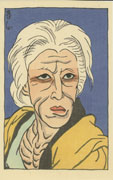 Nihon Hanga Kyokai (Japan PrintAssociation) - founded in 1931 by the merger of the Nihon Sosaku-Hanga Kyokai (Japanese Creative Print Association) and Yofu Hangakai (Western-Style Print Society). It is the largest association of print artists in Japan and continues to hold annual exhibitions. Nihon Sosaku Hanga Kyokai - formed in June, 1918 and included Kanae Yamamoto, Kazuma Oda, Kogan Tobari, Takeo Terazaki, Koshiro Onchi,Tsurozo Ishii, Itaru Tanabe, Yoshiro Nagase, Un-ichi Hiratsuka, SenpanMaekawa and Masahide Asahi. Its objectives were to disseminateinformation on the art of engraving, promote the print arts throughexhibitions and lobby to have prints exhibited at the Teiten (Salon ofthe Imperial Art Institute) and establish a Department of Engraving atthe Tokyo Academy of Fine Arts. It eventually succeeded in itsobjectives. nihonga (traditional Japanese-style painting) - term appearing in mid-Meiji period to differentiate artists working in traditional media from Western-style oil painters (yoga). Not a single style, it includes a number of art associations and artists desiring to express an aesthetic believed to be "Japanese" through the use of traditional materials. Nihonga (movement) - begun in the 1880s by Okakura Tenshin(1862-1913) as a reaction against Western imagery. He wasconcerned with cultural identity and aware that quality work could notbe produced by the mere adoption of Western forms and he urged thatJapanese style painting be remodeled to conform to the new age. Nihonga works were typically made with ink and mineral pigments on traditional silk and paper formats such as hanging scrolls, folding screens and sliding doors. nimaime - actor specialized in the roles of handsome and refined young lovers, often performed in the wagoto style. Nikakai - Second Division Association (Second Section Society) formed in 1914 by Ishii Hakutei, Yasui Sotaro, Sakamoto Hanjirō and other painters in opposition to the conservative official Bunten. They were sympathetic to European avant-garde ideas. The organization was still active in the late 1980s. nishiki-e ("brocade pictures") - term coined for the full-color woodblock prints appearing after 1764-65 that used more advanced printing techniques. Nitten (The Japan Fine Arts Exhibition) - the successor to the Bunten and Teiten. In 1946, after World War II, the management of the Imperial art Academy was taken over by the Japan Fine Arts Exhibition and the Nitten was formed. The Nitten Corporation was formed in 1958 to handle the annual exhibition. The Nitten is the most popular of all the major art organizations in Japan and consists of five sections covering Japanese style painting, Western style painting, sculpture, craft as art, and calligraphy. nochi-shite (nochijite) - in a two-part Noh play, the shite is maejite (“before-shite”) in the first part and nochijite (“after-shite”) in the second. noh - a kind of symbolic drama colored with the graceful aesthetic effect of quiet elegance that is expressed through the word yugen ("elegant, refined, and elusive beauty"). Its subjects are taken from history or classical literature, and it is structured around song and dance. oiran - the highest-ranking courtesan.  ōkubi-e ("large-head pictures") - large head format print; a bust portrait showing just the head andshoulders of the subject. (See also nagao-e and yakusha-e.) omacha-e - pictures of toys. onnagata - a male actor who plays female roles in kabuki; a female-impersonator (also called oyama). Order of Culture - One of Japan's most distinguished awards, based on the Government Ordinance on the Order of Culture issued in February 1937, and then presented annually by the Japanese Government to those who have made outstanding achievements in the fields of science, arts, literature, etc. ōtsue - small woodblock prints and sketches of popular religious subjects. By the end of the Genroku Era (1688-1704), they had become so popular they were transformed into talismans and other forms of artwork. Otsue ceased being produced in the 1880s. oyajigata - an actor who plays old men roles in kabuki. rakugo - is classified as a kind of yose, a form of Japanese vaudeville, named for the type of theater in which it is traditionally performed. In rakugo, a single kimono-clad storyteller sits on a cushion, legs folded tidily underneath, in the middle of the stage. The monologue has a three-part structure consisting of the makura (preliminary comments), the honmon (main body), and the ochi (the windup, also known as the sage). These are narrated in order, with a focus on humor. Saiko Nihon Bijutsuin (Reorganized Japan Fine Art Academy) - The 1914 reorganized Nihon-bijutsu-in (Japan Art Institute), established1898 by Tenshin Okakura, former president of Tokyo School of Fine Arts.Its exhibition is known as Inten. Sango-kai (Coral Society) - a small artists group centered on the activities of Nihonga painters. In Taisho 4 (1915) the group was formed by eight painters: Hirafuku Hyakusui as the main member, joined by Ikeda Eiji, Ogawa Usen (1868-1938), Ogawa Senyou, Kawabata Ryushi, Tsuruta Goro, Natori Shunsen (1886-1960), and Yamamura Toyonari (Kouka) (1885-1942). This group was active until its 10th exhibition held in Taisho 13 (1924). Morita Tsunetomo, Kondō Koichirō (1884 – 1962), and Ishizuka Kan (active c. 1915) joined the initial members midway through the group's history, and at the end of the group's activities, Sakai Sanryo and Okamoto Ippei exhibited works in the group's exhibitions. While technically exhibiting Nihonga works, Ogawa Usen and Kawabata Ryushi had both been trained in Western-style painting, and Tsurata Goro was an active Western-style painter, while Okamota Ippei and Ikeda Eiji were both manga artists. Thus the group was not necessarily a unified front, but rather a place where they could share interests and studies on an equal footing as individual friends and colleagues. It seems to have been a place for extremely free exchange. saku - made or done by (appearing with an artist's seal or signature.) sanhime (三姫)- The three most difficult and praiseworthy Princess roles in the kabuki repertoire: Yaegaki, Yuki and Toki in the plays "Honchō Nijūshikō", "Kamakura Sandaiki" and "Kinkakuji". sashi-e - literally, an "inserted picture." A new Meiji era idiom, sashi-e were dependent on and subordinate to narrative. Seikinkai (Blue Collar Society) - association of Japanese-style painters founded by the artists Ito Shinsui and Yamakawa Shūhō in 1939 senjafuda 千社札 (lit. thousand shrine tags) - votive slips offered at temples bearing the name of the worshipper and often a design. Pasted on gateposts and other temple structures, they were once considered a nuisance, but their popularity lead to the formation of senjafuda clubs which exchanged their designs with other clubs. See https://glam.uoregon.edu/yokaisenjafuda/page/welcome for an extensive view of this genre with a focus on yōkai senjafuda. seriography (silk screen) - a type of stencil printing, but instead of forcing inks through a stencil made with heavy paper, the inks are passed through a screen of silk, textile, or metal mesh stretched across a frame. sewamono - domestic dramas dealing with the lives of commoners and based on contemporary life or events. More realistic in style, scenery and costumes than the historical plays (jidaimono.) shamisen - long-necked three-stringed instrument played with a large plectrum. shasei - drawing from nature. shibai-e - picture of a play or drama shibaraku - a short drama of roughly 50 minutes, inserted during interludes in a kabuki play or in between fullplays to provide variety and maintain a certain level of energy andinterest on the part of the audience. Shigenkai - a society to exhibit Western-style painting founded in 1947 by Ishikawa Toraji and other Taiheiyo Gakai members who wanted greater freedom. Still active in 1989. shin hanga 新版画 - literally, "new prints"; the resurgent Japanese woodblock print movementbeginning in theTaishoperiod (1912-1926), which joined traditional Japanese woodblock subjects and printingtechniques, together with Western drawing techniques, to revitalize thetraditional woodblock print. shina - Japanese linden. Used to face plywood that in turn is used as the woodblock for many modern Japanese woodblock prints. shini-e ("death pictures") - pictorial obituaries announcing the demise of persons celebrated in popular culture. Memorial-pictures became popular in the second half of the Edo period(1603-1868) as reminiscence of deceased famous people (mostly famous actors and artists.) Aportrait of their life was drawn; their stage and posthumous name,cause and date of death, their deathbed poem etc. shinkabuki - New kabuki dramas written since Meiji by playwrights from outside the kabuki world. shite - the main actor in a Noh play who sometimes wears a mask. (Also see nochi-shite.) shōgun - supreme military rulers of Japan. shōgun jōraku-e (shogun’s procession-pictures) - 1863-64 the series shōgun jōraku’e about the proceeding of the shogun from Edo to the emperor in Kyōto emerged. Each of the “53 stations of the Tōkaidō” from Edo to Kyōto and the receiving at the emperor’s castle were displayed. Because depicting the shogun's procession to the emperor was forbidden, the Tokugawa shogun was replaced by Minamoto Yoritomo (1147–1199), the founder and the first shogun of the Kamakura Shogunate, in the pictures. shohan - first edition shomen zuri 正面摺 (front printing) - a printing process whereby areas of the print are rubbed with a hard polisher (such as a boar's tusk or agate) on the front surface, thus giving the print a burnished and shiny appearance. Also a technique for creating intricate patterns on the black areas of some prints by placing a carved block behind the print rubbing with a hard polisher. shūmei - name-taking ceremony for an actor. shunga - erotic images (literally "spring images", a typical euphemism for erotica);another of the classic original woodblock forms. sosaku hanga 創作版画- literally, "creative prints"; a Japanese woodblock print movement of the 20thcentury which utilized Western and modern concepts of art, inwhich the artist was more involved in the production of the prints (oftenundertaking the entire process on their own), and determined the subject matter andpresentation. stencil print (kappazuri) - pigment is forced through a stencil to the surface of a sheet of paper. The technique has a long history of use in textile and paper decoration. sumi - a black ink prepared by hardening carbon black in a glue matrix to form sticks. One of the most important painting materials in the East. sumizuri-e - literally, "black-ink printed picture"; sumi is the name for blackIndia ink. Hence sumizuri-e, a print done in black and white, althoughsometimes one finds shades of grey as well, as inHokusai'sfamous and fabulous illustrated book, '100 Views of Fuji'. Thefirstukiyo-eprints were produced with this technique. surimono - literally, "printed things"; privately issued and distributed prints, mostlyproduced in small numbers. Most had poetry (usually commissioned by privatepoetry clubs) orcalendarson them, and were often used as invitations, notices, holiday and greetingcards, etc. They were usually very finely printed, with elaborate and unusualprinting techniques such as use of powdered metals. tachiyaku - actor specialized in male kabuki roles. Taiheiyo Gakai (Pacific Western-style Art Society Institute) - a circa 1901 successor to the Meiji Fine Arts Society. Taikokan - painting school located in Nagatachō, Kojimachi tanka - literally "short poem". A waka poem in thirty-one syllables, arranged in five 5-7-5-7-7 syllable phrases. Developed in the late eighth century, it became an essential skill for an aristocrat. Over time it became the premier poetic form and the subject of competitions. tate-e (also tat-eye and tateban) - vertical (i.e. portrait) orientation. Tatsumi Gakai (Southeast Painting Society) - Japanese-style painting society of southeast Japan that started a hanga section in its 1916 annual exhibition. Teiten (Exhibition of the Imperial Art Academy) - In 1919, the Bunten was reorganized as the Teiten, under the new auspices of the Imperial Academy of Fine Arts. Tenshin Dojo - a school of Western art that taught a subjective and impressionistic interpretation of visual data in contrast to the more objective standards of the painting derived from the Barbazon school that had been taught in Japan from early Meiji times. Tōkaidō - the coastal route stretching from Nihonbashi in Edo to Sanjo Bridge in Kyoto with 53 port-towns, or stations, in between. (also see Kisokaidō.) Tokyo Koto Shihan Gakko (Tokyo Higher Normal School) - Higher Normal Schools came into being as a result of the various promulgation orders of the late 1890s. One higher normal school and one women's higher normal school were to be established in Tokyo, and one or more normal schools for each prefecture. torii 鳥居 - immense red gate; Shinto shrine archway torinoko - a smooth, semi-glossy paper (washi) made with mitsumata and the inner bark of ganpi, used for moku hanga. Tosa - the Tosa school of painters were official artists to theimperial court from the fifteenth to the end of the nineteenthcentury. They painted in the yamato-e style, often takingtheir themes from classical literature, especially Genjimonogatari ('The Tale of Genji'). The Tosa style is bright, with flat color in decorativecompositions combined with delicate outline and careful attentionto detail. Viewpoints are often sharply angled, looking intointerior spaces with, by convention, the roof removed(fuki-nuki yatai). tokiwazu - the samisen music that accompanied joruri  toshidama seal - seal of the Utagawa school 年玉. tsure - subsidiary actors in a Noh play  Ugokai (Cormorant Society) - a small organization of ukiyo-e illustrators organized by Kaburagi Kiyokata and Hirezaki Eihō, active from 1901-1912, that were concentrating on producing paintings. ukiyo-e - pictures of urban life, with a particular emphasis on the pleasures of the 'floating world': prostitution, fashion, kabuki, sumo and other recreations; now often used to describe Japanese woodblock prints ingeneral. wagoto - the "gentle style". One important kabuki acting style, usually opposed to the aragoto style. Speech and gesture in wagoto are much more realistic and delicate than in the aragoto style. wagotoshi - one subdivision of tachiyaku: a wagotoshi is an actor specialized in roles in the wagoto style. wahon 和本 - a book bound in the Japanese style waka - literally "Japanese poem". It is a poetic form original to Japan, as distinguished from Chinese original poetic forms. wakaonnagata - actor onnagata specialized in young maiden or princess roles. waki - the secondary actor, behind the shite in a Noh play. waki-tsure (wakizure) - the actor who accompanies the waki in a Noh play. washi - Japanese paper  woodblock print and woodcut - produced from plank blocks or boards, cut along the woodgrain. wood engraving - a print created by a block that has been cut across the grain and engraved with dedigns. yamato-e - translated as 'Japanese pictures', the term yamato-e is usedbroadly to distinguish Japanese pictures from kara-e ('Chinesepictures'), or it can be used to describe works which through theirsubject matter and style represent native Japanese taste. yamatotoji 大和綴 The simplest style of book-binding. The process of making yamatotoji involves punching four (or sometimes two) horizontal slits in the book near the spine and threading a flat cord (or sometimes a strip of paper) through each pair of slits. The cord ends are brought to the front, and each cord is secured tightly with a square knot. Yamatotoji also uses long corner pieces added to strengthen the otherwise unsupported corners. yōga - Western-style painting yoko-e (also yok-oye and yokoban) - horizontal (i.e. landscape) orientation. yokohama-e - prints from the Western enclave of Yokohama depicting scenes with Westerners. In 1858 a trade agreement with US-America was concluded, soon followedby similar agreements with Russia, England, France and the Netherlands.In the course of these agreements the harbors of Nagasaki, Hakodateand Yokohama were opened to foreign ships. Yokohama became an importantharbor for foreign trade and a lot of foreigners became residents ofthis city. The Yokohama-pictures dealt with Westerners themselves,their lifestyle and matters and objects concerning Westerners. Theygained great popularity. Yoyogi Group - print artists who gathered at Hiratsuka Un'ichi's (1895-1997) house in the Yoyogi district of Tokyo in the 1930s. zamoto - kabuki performances promoter during the Edo period. Owner of the right to organize kabuki performances. zangirimono ("cropped hair plays") - genre of sewamono dramas, created by the playwright Kawatake Mokuami and the actor Onoe Kikugorô V, dealing with contemporary events, especially those that dealt with the effects of the Meiji Enlightenment. A reference to the Western-style haircuts adopted by Japanese men after the Meiji Restoration. |
Home >


 ga
ga
